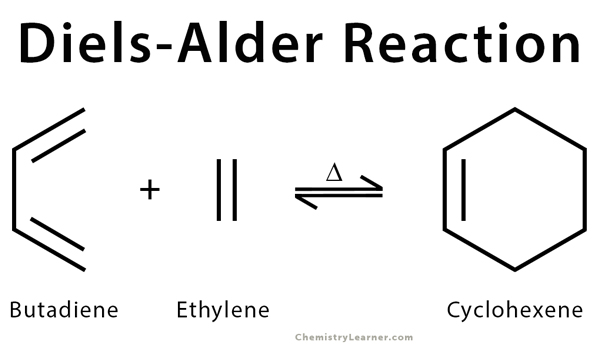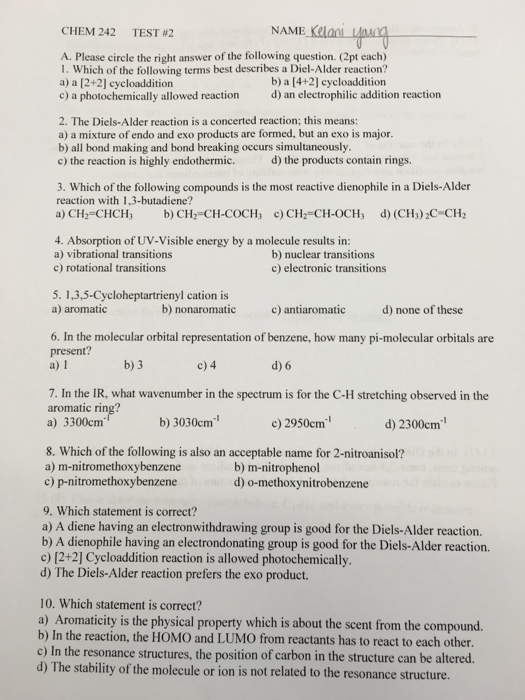How many grams of anthracene would one need in order to perform a Diels-Alder reaction on a 75 mmol scale. There could be more than one olefin in the product.

Solved 2 Which Of The Following Terms Describes A Chegg Com
In my experience one describes the relative positioning of the EWG and EDG substituents relative to each other the 12-product or 14-product is favored the 13-product is not usually formed.

. Essentially this process involves overlap of the 2p orbitals on carbons 1 and 4 of the diene with 2p orbitals on the two sp 2 -hybridized carbons of the dienophile. If you go through the FMO frontier molecular approach then you can see for 42 cycloaddition thermal condition is best. A Reaction with High Atom Economy Study Questions 1 Given the following reaction sequence and information draw an energy diagram Energy vs Reaction Coordinate illustrating the major energetic features of the following reaction.
Before we begin there are a few things to consider when carrying out the reaction. Retro Diels-Alder reaction of nitrogen bridgehead compound 415 at 100 C afforded 6789-tetrahydro-4-pyrido l2-upyrimidin-4-one and cyclobutadiene 97SC195. Pg254 Cyclo butadiene is highly reactive and shows none of the properties associated with aromaticity.
Four carbons hybridize from sp2 to sp3 these atoms have the potential to become tetrahedral stereocenters in the product. Moreover all of the atoms that are participating in the reaction form bonds simultaneously. Which of the following best describes a Diels-Alder reaction.
One is concerned with the reaction itself not the product as a whole. Diels-Alder reactions are concerted stereospecific and follow the endo rule. DielsAlder reaction can be described as a chemical reaction between the substituted alkene ie question_answer Q.
It is the prototypical example of a pericyclic reaction with a concerted mechanism. In fact it was not even prepared until 1965 when Rowland Pettit of the. For more information see ZN p 421-432.
Tap card to see definition. 2 Provide the products for the following Diels-Alder reactions. In a Diels-Alder reaction the alkene reacting partner is referred to as the dienophile.
Developed a modified protocol which allow αβ-unsaturated ketals to undergo facile ionic Diels-Alder cycloaddition in the presence of 40M. The LUMO of the dienophile reacts with the HOMO of the diene in a 42 cycloaddition. Discovered by Otto Paul Hermann Diels and Kurt Alder in 1928.
The Diels-Alder Reaction is a reaction used in organic chemical science that builds rings really expeditiously 1. Diels-Alder Reaction a very important reaction Reaction between a conjugated diene and an alkene dienophile to give a cyclohexene Diene Dienophile cyclohexene The Diels-Alder reaction is favored by electron withdrawing groups on the dienophile and electron donating groups on the diene. Reactivity of the Diene.
O O O O O H O R O OR H O H H H ethylene. The diene component on the other hand should be as electron-rich as possible. Thus a synthesis of a molecule containing several stereocenters via a Diels-Alder reaction may be particularly efficient.
The driving force of the reaction is the formation of new σ-bonds which are energetically more stable than the π-bonds. More specifically it is classified as a thermally-allowed 2 cycloaddition with. The Diels-Alder reaction is a concerted reaction this means it occurs in only one step.
Cyclopentadiene formed in situ reacted with the dienophile in a thermodynamically controlled reactionBesides being solvent-free the described procedure allows for almost complete utilization of dicyclopentadiene and avoids handling of noxious and. An alkene or alkyne The reaction is facilitated. In organic chemistry the DielsAlder reaction is a chemical reaction between a conjugated diene and a substituted alkene commonly termed the dienophile to form a substituted cyclohexene derivative.
Diels alder reaction is a pericyclic reaction more accurately a 42 cycloaddition reaction between a diene and a dienophile. Now try reversing that mechanism. The DielsAlder reaction a concerted 4 2 cycloaddition of a conjugated diene and a dienophile is a powerful tool for the regio- and stereoselective construction of six-membered rings 123456.
The regular Diels-Alder reaction despite usually being heated occurs at a lower temperature than when the reverse direction is favored and in these reaction conditions the equilibrium favors the product. A Diels-Alder reaction is a 42-cycloaddition of a conjugated diene and a dienophile eg. First a reminder that the Diels-Alder reaction is a type of a pericyclic reaction between a conjugated diene two double bonds and a dienophile an alkene with an electron-withdrawing group.
Diels -Alder Reactions The Diels-Alder cycloaddition of various dienes mostly belonging to 1-vinyl cyclohexenes with o-quinone proceeds very under ultrasound Intramolecular Diels-Alder and Alder Ene Reactions Springer New York 1984. Youll see this. The 42-cycloaddition of a conjugated diene and a dienophile an alkene or alkyne an electrocyclic reaction that involves the 4 π-electrons of the diene and 2 π-electrons of the dienophile.
In its original version two new CC bonds are created in the DielsAlder reaction and six-membered carbocyclic systems are obtained. Here with the expense of two pi-bond one sigma bond forms. The rate of a Diels-Alder reaction is favored by select all that apply electron withdrawing.
All you have to do is heat the product even more. Diels-Alder reactions are normally used to prepare what sized ring. A solvent-free DielsAlder reaction was carried out by heating a mixture of dicyclopentadiene and a dienophile.
Then the resultant retro-Diels Alder reaction favors the diene. The diels-alder reaction is composed of a reaction between a conjugated diene which is electron rich and a dienophile substituted alkene or alkyne electron deficient. 4 More recently Grieco et.
In the Diels-Alder cycloaddition reaction a conjugated diene reacts with an alkene to form a ring structure. Diels-Alder Reactions a more advanced discussion can be found in Appendix. By electron-withdrawing groups on the dienophile since this will lower the energy of the LUMO.
Awarded the Nobel prize in chemistry in 1950. These simultaneously make two carbon-carbon bonds and if the product lacks a plane of symmetry create four stereocenters in the process. Gassman and coworkers were the first to describe the ionic Diels-Alder reaction of αβ-unsaturated ketals as a useful means by which to prepare cycloadducts under mild reaction conditions.
This cycloaddition procedure allows for the stereoselective formation of cyclohexene rings possessing every bit many as four immediate stereogenic centres. DMacks 1515 8 May 2006.

Solved Which Of The Following Terms Best Describes A Diet Chegg Com

0 Comments